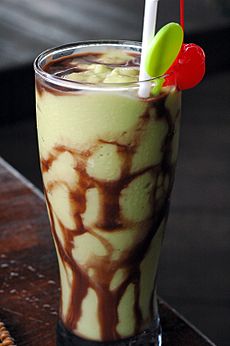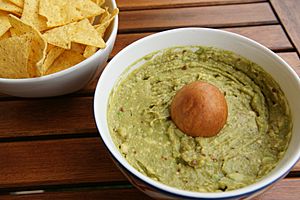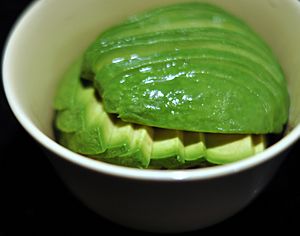Avocado facts for kids
Quick facts for kids Avocado |
|
|---|---|
 |
|
| Avocado fruit and foliage, Huntington Library, California | |
| Scientific classification | |
| Kingdom: | |
| Division: | |
| Class: | |
| Order: | |
| Family: | |
| Genus: |
Persea
|
| Species: |
P. americana
|
| Binomial name | |
| Persea americana |
|
An avocado is a yummy fruit that grows on trees. It's actually a type of berry! Avocados can have bumpy or smooth skin, and their color can be medium or dark green, depending on the kind.
Inside, the avocado has a bright green color near the skin, fading to a lighter green closer to its big seed. It feels super creamy and smooth when you eat it.
Avocado trees originally came from Central America and Mexico. Today, they grow in many warm places around the world where it doesn't get too cold.
Avocados have more fat than most other fruits. But don't worry, most of this fat is the healthy kind, called unsaturated fat, which is good for your body! They are also packed with good stuff like potassium (which helps your muscles work), and important vitamins like B, E, and K.
A super popular Mexican dip called guacamole is made from avocados. Many other tasty foods also use avocados.
Just so you know, avocado leaves can be poisonous to some animals, so it's best to keep pets away from the plants.
Growing Avocados
Avocado trees like warm weather and don't do well in cold places. They need a climate without frost and with not too much wind. Strong winds can dry out their flowers and make it harder for them to grow fruit.
Even a little bit of frost can make the fruit fall off early. However, one type called 'Hass' can handle temperatures as low as -1°C (30°F).
These trees also need good soil that lets water drain easily, ideally more than 1 meter (3 feet) deep. If the water used for irrigation is too salty, it can reduce how much fruit the trees produce.
You can find avocados growing in many places around the world. These include parts of southern California, Florida, Hawaii, Mexico, Central America, and countries like Spain, South Africa, Australia, and New Zealand. Different regions often grow different kinds of avocados.
How People Eat Avocados

Avocados have a lot more healthy fat than most other fruits. This makes them a great food for people who might not get enough healthy fats from other sources like meat or fish.
Avocado oil is also made from avocados. It's more expensive than regular cooking oils, but it's great for salads or dips.
When an avocado is ripe, it will feel a little soft if you gently squeeze it in your hand. After you cut an avocado, its green flesh can quickly turn brown when it touches the air. To stop this, you can add a little lime or lemon juice to it.

Avocados don't taste sweet. They have a unique, mild flavor and a smooth texture. People use them in both savory (like salty or spicy) and sweet dishes, though in many countries, they are usually only used in one way.
Avocados are very popular in vegetarian cuisine. They are often used instead of meat in sandwiches and salads because they are so creamy and filling.
Most of the time, avocados are eaten raw. Some types, like the common 'Hass' avocado, can be cooked for a short time without becoming bitter. But be careful when cooking other types, as some avocados can become inedible if heated too much. Cooking them for a long time will make all types of avocados taste bad.
Avocado is the main ingredient in the famous Mexican dip called guacamole. It's also spread on corn tortillas or toast, often with spices.
In countries like the Philippines, Brazil, Indonesia, and Vietnam, avocados are often used to make milkshakes. They are sometimes added to ice cream and other desserts too. In Brazil, Vietnam, and Indonesia, people make a sweet drink with sugar, milk or water, and pureed avocado. Sometimes, they even add chocolate syrup! In Morocco, a similar cold avocado and milk drink is sweetened and flavored with orange flower water.
In Ethiopia, avocados are blended with sugar and milk or water to make juice. It's also common to see layered fruit juices in a glass, with avocado, mango, banana, guava, and papaya all together. Avocados are also used in salads there.
In Portuguese-speaking countries like Brazil, avocados are traditionally mashed with sugar and lime and eaten as a dessert or snack. This is different from Spanish-speaking countries like Chile or Mexico, where sweet avocado dishes are rare.
In Australia and New Zealand, avocados are commonly put in sandwiches, sushi, on toast, or served with chicken. In Ghana, people often eat it alone with sliced bread as a sandwich. In Sri Lanka, ripe avocado mashed with sugar and milk (or a sweet syrup called treacle) is a popular dessert. In Haiti, it's often eaten with cassava or regular bread for breakfast.
In Mexico and Central America, avocados are served with white rice, in soups, salads, or on the side of chicken and meat dishes. In Peru, they are eaten with tequeños (a type of fried cheese stick), served as a side dish with grilled meats (parrillas), used in salads and sandwiches, or as a whole dish when filled with tuna, shrimp, or chicken. In Chile, it's used as a creamy sauce with chicken, hamburgers, and hot dogs. It's also sliced into celery or lettuce salads. The Chilean version of Caesar salad includes big slices of ripe avocado. In Kenya and Nigeria, avocados are often eaten as a fruit by themselves, or mixed with other fruits in a fruit salad, or as part of a vegetable salad.
Avocado is a main ingredient in avocado soup. Slices of avocado are often added to hamburgers, tortas, hot dogs, and carne asada (grilled meat). Avocados can be mixed with eggs (in scrambled eggs, tortillas, or omelettes), and they are a key ingredient in California rolls and other makizushi (rolled sushi).
In the United Kingdom, avocados became available in the 1960s. They were first introduced by a store called Sainsbury's and were known as 'avocado pears'.
Images for kids
-
Native Oaxaca criollo avocados, the original form of today's domesticated varieties
-
The first international air shipment of avocados from Los Angeles to Toronto for the Canadian National Exhibition, 1927
-
Avocado has elliptical-shaped leaves
See also
 In Spanish: Aguacate para niños
In Spanish: Aguacate para niños












